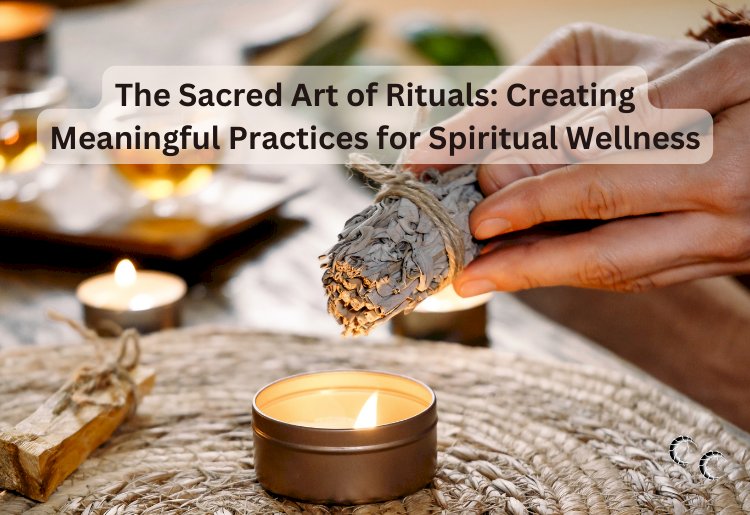The Sacred Art of Rituals: Creating Meaningful Practices for Spiritual Wellness

Rituals have been an integral part of human culture and spirituality since ancient times, serving as powerful tools for connecting with the divine, fostering community, and promoting spiritual wellness. Whether simple daily practices or elaborate ceremonial rites, rituals provide a sense of structure, meaning, and continuity in our lives, helping us to cultivate a deeper sense of purpose, connection, and inner peace. In this article, we'll explore the sacred art of rituals and share how you can create meaningful practices to enhance your spiritual wellness:
-
Set Intentions: The foundation of any meaningful ritual is setting clear intentions—what do you hope to achieve or experience through the practice? Take time to reflect on your intentions for the ritual, whether it's seeking guidance, healing, or connection with the divine. Clarify your intentions and infuse them with sincerity and heartfelt intention, knowing that they will guide and inform the ritual's purpose and significance.
-
Create Sacred Space: Create a sacred space for your ritual—a dedicated area where you can connect with the divine and cultivate a sense of reverence and sanctity. This space can be as simple as a corner of your home adorned with candles, crystals, or sacred symbols, or as elaborate as an outdoor altar surrounded by nature. Set the stage for your ritual by cleansing the space with sage, incense, or holy water, and inviting in the presence of the divine.
-
Engage the Senses: Rituals are a multisensory experience, engaging all of our senses to deepen our connection with the divine and evoke a sense of presence and reverence. Incorporate elements that appeal to the senses, such as candles for sight, incense for smell, bells or chimes for sound, and sacred objects for touch. Create a sensory-rich environment that invites you to fully immerse yourself in the ritual and experience its transformative power.
-
Follow a Ritual Structure: While rituals can be spontaneous and intuitive, they often follow a basic structure or sequence of steps to guide the process and create a sense of flow and coherence. Begin your ritual with an opening invocation or prayer to set the intention and invoke the presence of the divine. Then, engage in symbolic actions, such as lighting candles, offering prayers or blessings, or performing sacred gestures or movements. Conclude the ritual with a closing blessing or affirmation, expressing gratitude for the gifts received and the connections made during the practice.
-
Embrace Rituals in Daily Life: Incorporate rituals into your daily life as a way of infusing your routine with meaning, mindfulness, and spiritual awareness. This could be as simple as a morning meditation practice, a daily gratitude ritual, or a bedtime reflection. Find moments throughout the day to pause, connect with the divine, and cultivate a sense of presence and gratitude. By embracing rituals in daily life, you create opportunities for spiritual growth and transformation in the midst of the ordinary.
-
Personalize Your Practice: Make your rituals personal and meaningful by tailoring them to your unique spiritual beliefs, preferences, and experiences. Draw inspiration from various spiritual traditions and practices, but don't be afraid to experiment and adapt them to suit your needs and intentions. Incorporate elements that resonate with you, whether it's sacred symbols, rituals, or prayers, and infuse your practice with your own creativity, intuition, and authenticity.
-
Reflect and Integrate: After completing a ritual, take time to reflect on your experience and integrate any insights or lessons learned into your life. Journal about your thoughts, feelings, and experiences during the ritual, and consider how they relate to your intentions and spiritual journey. Notice any shifts or changes in your energy, mood, or perspective, and be open to the guidance and wisdom that emerge from the practice. By reflecting and integrating your ritual experiences, you deepen your connection with the divine and foster spiritual growth and transformation.
In conclusion, the sacred art of rituals offers a profound pathway to spiritual wellness, providing a means of connecting with the divine, fostering mindfulness, and cultivating inner peace and harmony. By setting intentions, creating sacred space, engaging the senses, following a ritual structure, embracing rituals in daily life, personalizing your practice, and reflecting and integrating your experiences, you can create meaningful rituals that nourish your soul, deepen your spiritual connection, and enrich your life with purpose, meaning, and joy.


























